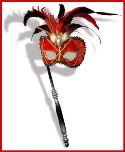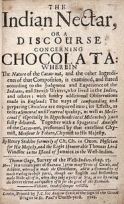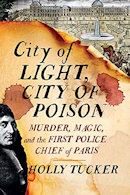Angélique - The Road to Versailles
Angélique -' The Road to Versailles' is the second half of the original hardback tome entitled Angélique, Marquise of the Angels (or to give it its original French title Marquise des Anges).
In this half of the book Angélique finds herself an outcast from society and like her predecessor Scarlet O'Hara ('Gone with the Wind' was published in May 1936 even though it was set in the American Civil War - 1861 to 1865) determines to win back what is rightfully hers. (She does it with chocolate!) Most likely as difficult a  proposition for a woman in the 1660s as in the 1860s - two hundred years separating the heroines but with little support for women's rights. This my favourite from the 'Old World'
proposition for a woman in the 1660s as in the 1860s - two hundred years separating the heroines but with little support for women's rights. This my favourite from the 'Old World'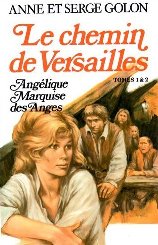 selection and I did not appreciate the richness of content until I re-read it some years ago as my review date attests and then read the book in Polish. Each language adds or subtracts something from the whole but being able to follow the books in two languages and sometimes three fills in lots of gaps - gaps which are further being enhanced now by Anne Golon who continues to work on her Intégrale.
selection and I did not appreciate the richness of content until I re-read it some years ago as my review date attests and then read the book in Polish. Each language adds or subtracts something from the whole but being able to follow the books in two languages and sometimes three fills in lots of gaps - gaps which are further being enhanced now by Anne Golon who continues to work on her Intégrale.
Exactly what did happen to this woman when her husband was accused of sorcery, was divested of his titles and sentenced to burn in the Place de Grève? She becomes persona non-grata - society shuns her - who will help her? Her husband has no direct family to speak of, his friends at court are all looking over their shoulders to see if they might be next, her sister Hortense, wife of a lawyer realises the implications to her own life and refuses to take her in save for a short while and until Angéliques money runs out. Her rivals at court are laughing their heads off at their own good fortune - another obstacle to the King removed from their own paths of glory. Her younger sister Marie-Agnés, a court courtesan and her brother, Gontran the painter are helpless, Josselin is in the New World or dead, the family in Poitou are scraping a living and Raymond has become a Jesuit - so where is left to escape from the Sun King? The Paris Underworld appears to be the only safe haven for Angélique at this time. From Heaven to
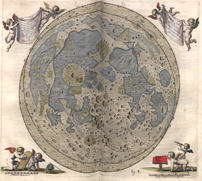 Hell - from the Sun to the Moon and its dark and ugly side (a magnificent engraving by Johannes Helvius from 1645 shows the style of the day).
Hell - from the Sun to the Moon and its dark and ugly side (a magnificent engraving by Johannes Helvius from 1645 shows the style of the day).
The Paris underworld, also famous as the 'Court of Miracles' so called because this was the place where all beggars and the afflicted where 'cured' and 'relieved' of their ailments when darkness fell. How could this cure be effected? These beggars and tricksters were not genuinely crippled or sick - they mimicked their symptoms in the most ingenious ways to gain sympathy and money from the unsuspecting, but as they returned to their lair, gone were the crutches, the scabs, the festering wounds,the toothless grins, the blind, the limbless as they unravelled their limbs or tore off their makeshift make-up and produced the bounty that would be shared and would contribute to their survival.
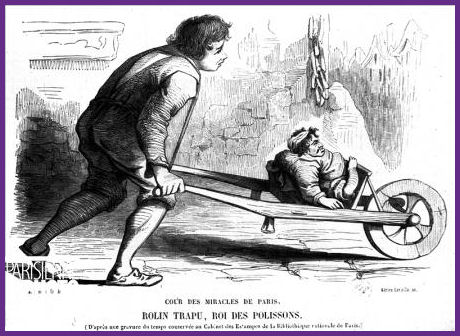
Image of men with wheelbarrows courtesy of Paris en images attributed to Gravure de Jacques-Adrien Lavielle d'après Racinet.
Victor Hugo introduced us to this macabre world in the 1800s when we met the 'Hunchback of Notre Dame' a genuinely crippled outcast who couldn't remove his 'hump' at night.
This is how Paris will have looked at the time of the action in the mid-1600s:
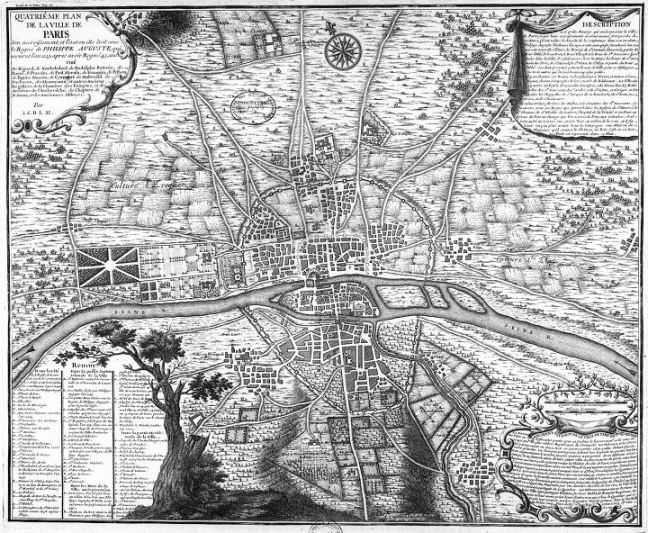
This would have been the location of the Court of Miracles :
And finally engravings by Gustav Doré, Master Engraver, of what the Court of Miracles might actually have looked like:


Sourced from an illustration in 'The Hunchback of Notre Dame' by Gustave Doré (Public Domain)
The Court of Miracles
In a nutshell thanks to atlasobscure.com : "Cours des Miracles (Court of Miracles)
Beggars were miraculously "cured" of their fake ailments when they returned home to this 17th century Paris slum each night. The poor and homeless population of Paris ballooned during the reign of Louis XIV, from 1654 to 1715, leading to terrible slums in the city center where the unemployed and destitute relied on begging to survive. The least fortunate of Paris would venture out onto city streets during the day wearing guises like physical disability or disease in hopes of evoking sympathy.
But come nightfall, when the poor returned home to the slum and there was no more need to feign illness, they were miraculously "cured" of these ailments. The blind could see; the lame could leap. Hence one of the poorest and most notorious 17th century slum districts of Paris became known as the Cours des Miracles, or Court of Miracles.
In the late 18th and early 19th centuries, the large slums were demolished during the Haussmannisation renovation of Paris following the French Revolution. But the Court of Miracles was cemented in history: It inspired the settings of two of Victor Hugo's famous novels, Les Misérables and The Hunchback of Notre-Dame. (The Court of Miracles even has its own song in the Disney animated adaptation of the latter.) In Hunchback, Hugo describes the slum as it once stood: "a gutter of vice and beggary, of vagrancy that spills over into the streets of the capital […] immense changing-room of all the actors of this comedy that robbery, prostitution and murder play on the cobbled streets of Paris.""
Somehow I think the 'Court of Miracles' merits more than this short synopsis, Anne Golon set the second half of her original book 'Angélique, Marquise of the Angels' in this very special location. It started with the downward spiral of everything that Angélique held dear. Her husband tried and convicted as a Sorcerer, his life to end on a pyre outside Notre Dame skirting the boundaries of the Court of Miracles. Her family shunning her for having been married to the Sorcerer despite the fact that this same 'arranged marriage' had helped them out of debt and allowed them to lead reasonably comfortable lives. The rejection of her children fathered by the Sorcerer The fall from grace and the alienation of the Sun King; her sisters' triumph in Angéliques downfall; the helplessness of her prominently placed Jesuit brother Raymond restrained by his vows and loyalty to the King. The distribution of all of Joffrey's possessions hence leading to the obliteration of the name of Peyrac and the titles of Toulouse and others from existence - where indeed, does one go when one is shunned from this world in such a public way?
The decision is made - find shelter in the 'Court of Miracles' - but can anyone find sanctuary there? Not if you didn't subscribe to the 16 Street Laws that governed entry to this place of 'sanctuary.' Anne Golon, however, knowing that her heroine must survive (I don't apologise for the use of female gender in this case) made an opening for Angéliques' entry to this curious underground kingdom, she resurrected an old childhood friend in the form of Nicholas who himself had been shunned by the Poitiers community earlier in part one of the book! By the time we meet him again, Nicholas has established himself as one of the leaders of the subterranean city and was firmly ensconced with maîtresse-en-titre 'La Polack'. The two women could not have been less alike from their blonde/brunette hair colour to their ancestral roots - fireworks were about to go off! 'La Polack' is of necessity one of my favourite characters in the book and Anne Golon gave me the pleasure of telling me that I had chosen well and that she, too approved greatly of the characters. What she didn't tell me was that in due time she would resurrect the character in Canada. Oh, how we have all missed out on the continuing adventures by not having the existing three books translated. Luckily, I have read them and know the (continuing) story of Janine Gonfarel.
'Law and Order' within the The Court of Miracles
The full 16 Street Laws can be found here, the areas pertinent to this par of the book are reproduced and condensed below (retaining the original numbering) :
16 Street Laws in Paris Shaped by the Infamous Court of Miracles
The Parisian slums of the 17th century were a wild place. Unlike most other cities, Paris had numerous slums throughout the city. Each tenement had its own culture, hierarchy, and language. Despite the prosperous and famed reign of Louis XIV, the Sun King, the peasants of France were as poor as ever. Many rural French fled to Paris to seek better fortune than they were finding in the country. Many of these refugees* became beggars. To increase their earnings, these beggars often pretended to be sick or disabled during the day, while miraculously healing when work was done at night. Indeed the Court of Miracles.
*Nicholas - however he climbed the ladder to the top and during the course of the book is not referred to as a beggar but more a type of 'Beggar King.'
16. Victor Hugo* Drew Inspiration From the Court of Miracles
Hugo found a great deal of inspiration in the historical and anthropological account of the Court of Miracles written by historian Henri Sauval. The criminal and desperate underbelly must have held a great deal of fascination for the well-bred Hugo, who was the comfortably middle-class son of a general and a painter. Hugo once floridly described the court, calling it, "a gutter of vice and beggary, of vagrancy that spills over into the streets of the capital […] immense changing-room of all the actors of this comedy that robbery, prostitution and murder play on the cobbled streets of Paris. Both of Hugo's most famous novels (Hunchback of Notre Dame and Les Misérables derived a great deal of inspiration from the depictions of poverty and suffering that appeared so broadly through Savual's documentation of the Court. While Hugo's characters are far better known than any of the true stories of the Court, one can glimpse a few their lives through his fiction.
It took some time for Sauval's writings on the Court to be widely recognized. It was unpopular and little published soon after printing, as the details were considered salacious and seditious. However, about a half-century after its creation, the historical accounts began to receive greater attention and respect as a historical and anthropological work. (From point 5)
* As did Anne Golon who also wrote fiction that had been very well researched but not enough to be mentioned in the same breath as Victor Hugo,
15. The Court of Miracles Was the Name of the Parisian Slums
Cour des Miracles was the French description, meaning Court of Miracles, for the network of slums throughout Paris. The best known of which lay between the rue (street) de Caire and the rue Réamur and called the Grand Court of Miracles, or simply Grand Court. Thanks to the careful documentation of the slums by French historian Henri Sauval, we now know that in reality, the Court of Miracles was an extensive network of slums that ran through Paris in its entirety.
Perhaps as ironic as the name Court of Miracles for a slum is the fact that the shining Palace of Versailles, home of the Sun King Louis XIV, sat amidst the poverty and desperation of the Court. The number of people living within the slums multiplied greatly during his reign as desperate laborers and farmers left* the barren countryside seeking a source of income in the city. The refugees to the city soon found that no paid work was available for them through honest means, and most ended up forced into one of the Court's numerous slums. There, they would end up having to engage in begging, theft or prostitution to survive. Thieving was easily the most stable and profitable of the three, as the thieves had a hierarchical and well-organized structure throughout the city.
* or were evicted as in the case of Nicholas.
13. The Slum Residents Had Their Own Social Hierarchy
Instead of a unified front, the residents of the slums found themselves sorted into veritable classes within a slum social hierarchy. People were categorized by the jobs they undertook in the slums, whether it was thievery, begging or prostitution. Within the broader classes defined by jobs, there were further hierarchies. Beggars referred to as the 'courtads de Boutange', were only allowed to solicit during the winter. Other classes included the 'malingreux', who faked illness for their begging. The 'narquois' were those who pretended to be injured or disabled for their begging, often pretending to be veterans of Louis XIV's ongoing wars. Thieves were quite high in the social order since they received regular wages from their employers higher up in the thief hierarchy. Young thieves were treated almost as apprentices and would therefore also have enjoyed much higher social standings than beggars.
12. Each Social Group Had Its Own Slang and Organization
The social structures and hierarchies within the Court of Miracles were clearly delineated, to the extent that some of the "classes" within the slums began to resemble their autonomous societies. Some of the classes, such as thieves, had clear leadership and coordinated direction between tenements. Others even developed their own unique slang language that would be used to communicate without other slum residents being able to understand. The beggars had a clear and rigid hierarchy, with the names of the officers coming from the beggars' slang itself. The equivalent of the king of the beggars was originally called the 'ragot', but later became known as the 'chef-coërsre'*. The 'chef-coërsre' was served by assistants called 'ducs'. Below the 'ducs' were the 'archissupots'. The 'archissupots' were former students of the beggars' slang who took on the role of teaching the slang to newly initiated beggars. The existence of the slang is preserved in modern knowledge thanks to the incredibly detailed accounts of historian Henri Sauval. His depictions of the day to day life of the Court's residents included diagraming the hierarchies of how the societies operated, including the slang languages unique to various groups. It is interesting to note that the poorest of France's residents constructed social classes as rigid and elaborate as those in shining Versailles who lived at their expense.
* Angélique and La Polack found a mutual respect for each other as they embarked on a rescue mission to wrest back Angéliques' sons from the 'Chef-Coërsre' who had bought them from the gypsies who in turn had procured them from an unscrupulous wet-nurse where they had been placed by Hortense, Angéliques disreputable older sister!
11. The Court of Miracles Is Popular Fodder for the Arts*
Victor Hugo was not the only artist fascinated by Henri Sauval's vivid and detailed descriptions of life in the 17th century Court of Miracles. Many other artists in both literature and visual art were intrigued by the period and represented it in various formats. French painter, illustrator and engraver Célestin Nanteuil was similarly intrigued by the Court and created the painting 'Gringoire In the Court of Miracles'. Gringoire is a mildly fictionalized character based on Pierre Gringoire, a French playwright, and appears in The Hunchback of Notre Dame. Countless sketches, maps, and engravings also depict the various classes of beggars within the Court. There is even an illustration that illustrates the different social orders within the beggars' society along with their titles. "Poverty porn," in which portrayals of suffering are intended to invoke sympathy to sell newspapers, art, etc. has been existence for centuries, and one wonders if some of the fascinations with the Court of Miracles stemmed from a similar phenomenon.
* But still no inclusion of Anne Golons' Angélique
10. One Had to Be Initiated Into the Court of Miracles
One of the most interesting aspects of the Court of Miracles was that it was not an automatically welcoming society to the downtrodden. If one wanted to join the organization, or community, of thieves within the Court they had to survive two purse-cutting tests. Thanks to the rigidly hierarchical nature of the Court societies, especially the thieves' group, more experienced members had the right to set criteria and rituals for new people wanting to join.
The first purse-cutting ritual for potential thieves required candidates to cut a purse covered in bells without making any sound. The second test was far more dangerous. The second purse-cutting challenge saw candidates dragged to a public marketplace or another densely populated area. The master overseeing the test would instruct the candidate to pick several pockets or cut several purses. Once the master was satisfied with a target the candidate had acquired, they would yell "thief" and flee, leaving the candidate alone in an angry crowd. The test was meant to establish if a candidate had the quick wits and fast feet required to stay out of trouble within the city.
The rigid structure of the thieve's group served an eminently practical purpose: ensuring no part of the city was over-robbed to avoid attracting undue police attention. The group of thieves worked to ensure that each portion of the town had the correct number of active thieves. It must have been a tricky balance to keep apprentices and master thieves employed while also ensuring they didn't steal enough to trigger a significant law enforcement crackdown. (From point 6)
* Happily Anne Golon gave Angélique a much simpler way in, but the criteria described above were included in her portrayal of the 'Court of Miracles.'
9. Begging Was Despised by the Wealthy French
The wealthy residents of Paris did not wish to be reminded of the pervasive poverty and decay in the city. Begging was deeply frowned upon by all ranks of society, but especially hated by the uppermost echelon. Louis XIV developed a police force,* by royal proclamation, to deal with the crime and poverty in the Court by any means necessary. The newly created effect imprisoned many residents of the Court for petty crimes, and, in some cases, solely for being poor or ill. Hospitals that used to serve the more impoverished communities were repurposed to house those committed by the police forces.
* Anne Golon creates Francois Desgrez who is part fiction/part fact and had him report to Nicolas de La Reynie who in turn reported to Colbert both very real historical characters very well covered by Professor Holly Tucker in her 'Let there be Light' educational essay.
7. The Court Was at Its Peak During the Reign of The Sun King
At the peak of Louis XIV's reign, over 10% of the population of Paris was destitute and lived in slums. The cost of bread was exorbitantly high and amounted to over 60% of a household's wages in a year. Despite these conditions, 5% of France's entire income was dedicated to maintaining Louis XIV's lavish palace of Versailles in the center of Paris. The population density of the Court would boggle the modern mind. At one point, small buildings were holding dozens of men, women, and children. There was one person for every three square meters of the city, which would likely have been far, far more dense in the crowded slums. It wasn't until after the French Revolution of the 19th century that the tenements were demolished and redesigned to be much larger, safer and more sanitary.
2. The Court Led to the First Modern Police Force
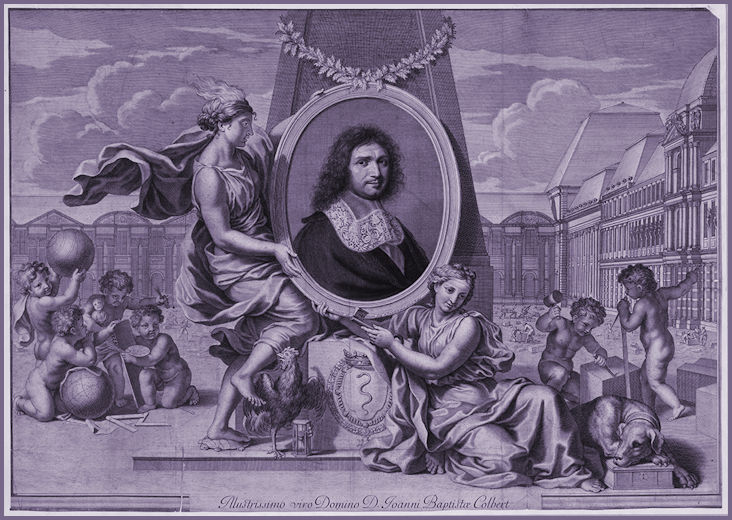
Jean-Baptiste Colbert - image courtesy and © of the Library of Congress
The disdain of begging and the sight of poverty led French politicians to take action against the Court of Miracles in the latter half of the 17th century. Jean-Baptiste Colbert presented King Louis XIV with a proclamation that would establish an office of Lieutenant General of Police, which would enable the office holder to create a police force comparable to modern police forces. King Louis XIV approved, and Gabriel Nicolas de la Reynie was installed as the first holder of the office. De la Reynie's task was to create a force that would both protect and preserve the more beautiful portions of the city while inhibiting the growth of the unpopular slums known collectively as the Court of Miracles. De la Reynie held the office from 1667 to 1697. During his time in office, he held a very modern view of law enforcement and developed police units and tactics that influenced the development of current police forces.
1. The Beggars Were Magically Cured Each Night, Hence the Court's Name
There were several noteworthy exceptions to the general disdain for beggars. War veterans, orphans, the ill and the disabled were seen as legitimate charity cases, and their begging was not frowned upon the same way as that of non-disabled adults. The wealthy Parisian citizens were far more likely to open their purses to help those they viewed as valid charity cases. These exceptions were common knowledge to the beggars, so it became commonplace for beggars to prepare for their day of work by applying make up or other devices* to appear sick or disabled. Limbs were bound with a cloth to fake amputation; makeup was used to replicate skin conditions* or diseases, among other effects. At night, after the day's begging was done, the beggars would return home and seem to miraculously heal of their ailments as limbs were freed and diseases disappeared. The name, Court of Miracles, is a reference to this practice as grievously afflicted men and women healed magically every night. Additional Sources : ranker.com
*Anne Golon described this technique in detail for our education and to introduce the concept of why the 'Court of Miracles' was so called, She described the use of honey and bread crusts as part of the 'other devices' (for skin diseases and the wrapping of limbs in bandages to give the appearance of amputation) rather than any form of 'make-up' although it would have existed as theatres, street theatres, opera and ballet were all entertainments during the period concerned.
Page updated : 28th August 2019 (G)

